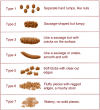Review article: diagnosis, management and patient perspectives of the spectrum of constipation disorders
- PMID: 33909919
- PMCID: PMC8252518
- DOI: 10.1111/apt.16369
Review article: diagnosis, management and patient perspectives of the spectrum of constipation disorders
Abstract
Background: Chronic constipation is a common, heterogeneous disorder with multiple symptoms and pathophysiological mechanisms. Patients are often referred to a gastroenterology provider after laxatives fail. However, there is limited knowledge of the spectrum and management of constipation disorders.
Aim: To discuss the latest understanding of the spectrum of constipation disorders, tools for identifying a pathophysiologic-based diagnosis in the specialist setting, treatment options and the patient's perspective of constipation.
Methods: Literature searches were conducted using PubMed for constipation diagnostic criteria, diagnostic tools and approved treatments. The authors provided insight from their own practices.
Results: Clinical assessment, stool diaries and Rome IV diagnostic criteria can facilitate diagnosis, evaluate severity and distinguish between IBS with constipation, chronic idiopathic constipation and dyssynergic defecation. Novel smartphone applications can help track constipation symptoms. Rectal examinations, anorectal manometry and balloon expulsion, assessments of neuromuscular function with colonic transit time and colonic manometry can provide mechanistic understanding of underlying pathophysiology. Treatments include lifestyle and diet changes, biofeedback therapy and pharmacological agents. Several classes of laxatives, as well as prokinetic and prosecretory agents, are available; here we describe their mechanisms of action, efficacy and side effects.
Conclusions: Constipation includes multiple overlapping subtypes identifiable using detailed history, current diagnostic tools and smartphone applications. Recognition of individual subtype(s) could pave the way for optimal, evidence-based treatments by a gastroenterology provider.
© 2021 The Authors. Alimentary Pharmacology & Therapeutics published by John Wiley & Sons Ltd.
Figures




Comment in
-
Letter: non-invasive transabdominal stimulation device for the treatment of chronic constipation-proof-of-principle study in adults. Authors' reply.Aliment Pharmacol Ther. 2022 May;55(10):1357-1358. doi: 10.1111/apt.16910. Aliment Pharmacol Ther. 2022. PMID: 35472179 No abstract available.
-
Letter: non-invasive transabdominal stimulation device for the treatment of chronic constipation-proof-of-principle study in adults.Aliment Pharmacol Ther. 2022 May;55(10):1354-1356. doi: 10.1111/apt.16877. Aliment Pharmacol Ther. 2022. PMID: 35472181 No abstract available.
References
-
- Suares NC, Ford AC. Prevalence of, and risk factors for, chronic idiopathic constipation in the community: systematic review and meta‐analysis. Am J Gastroenterol. 2011;106:1582‐1591. - PubMed
-
- Rao SS, Camilleri M. Approach to the patient with constipation. In: Podolsky DK, Camilleri M, Fitz JG, Kalloo AN, Shanahan F, Wang TC, eds. Yamada's Textbook of Gastroenterology. Hoboken, NJ: Wiley; 2015:757‐780.
-
- Serra J, Mascort‐Roca J, Marzo‐Castillejo M, et al. Clinical practice guidelines for the management of constipation in adults. Part 1: definition, aetiology and clinical manifestations. Gastroenterol Hepatol. 2017;40:132‐141. - PubMed
-
- Sharma A, Rao S. Constipation: pathophysiology and current therapeutic approaches. Handb Exp Pharmacol. 2017;239:59‐74. - PubMed
-
- Basilisco G, Coletta M. Chronic constipation: a critical review. Dig Liver Dis. 2013;45:886‐893. - PubMed
Publication types
MeSH terms
Substances
Grants and funding
LinkOut - more resources
Full Text Sources
Other Literature Sources
Medical
